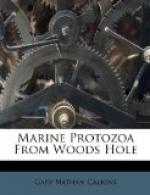c. Mouth posterior; form
Family Microthoracidae
asymmetrical; cilia dispersed
or limited to oral region
d. Mouth anterior or central.
Paramoecidae
Peristomial depression (One genus,
Paramoecium)
clearly marked.
e. Mouth at end of long
peristome Family Pleuronemidae
running along ventral side;
body dorso-ventrally or
laterally compressed; left edge
of peristome with great, sail-
like undulating membrane
f. Mouth and pharynx distinct,
Family Isotrichidae
posterior; cilia uniform.
Parasites in ruminants.
g. Mouth absent; body vermiform,
Family Opalinidae
cilia uniform. Usually
parasites.
KEY TO MARINE GENERA OF ENCHELINIDAE
Diagnostic characters: Form ellipsoid or ovoid; the mouth is invariably terminal and is usually round—more rarely slit-formed; it is closed except when food is taken. An oesophagus when present is a short, invariably non-ciliated tube which is usually surrounded by a more or less clearly defined buccal armature. The anus is usually terminal. Large food particles are swallowed, never introduced by currents.
1. Body naked 3
2. Body inclosed in a shell or coat 7
3. a. Cilia uniform about the
entire 4
body; body symmetrical
b. Cilia in the mouth region
5
longer than the others; body
symmetrical
c. Bristles, or tentacles,
in 6
addition to cilia
4. Mouth terminal; body ellipsoidal
Genus Holophrya
to ovoid
5. a. Mouth terminal; body
elongate, Genus Chaenia
flexible, and elastic
b. Mouth terminal; “neck”
highly Genus *_Lacrymaria_
elastic; entire body
flexible; conical “head”
c. Mouth terminal; “neck”
highly Genus *_Trachelocerca_
elastic; entire body
flexible; “head” square
d. Mouth terminal; “neck”
highly Genus Lagynus
elastic; no separate
mouth-bearing portion
6. a. Body asymmetrical; bristles
Genus Stephanopogon
in addition to cilia
b. Body symmetrical; 4 small
Genus *_Mesodinium_
tentacles from mouth; cilia
and cirri in girdles
7. Shell composed of small
Genus *_Tiarina_
sculptured pieces; cilia long,
uniform
* Presence at Woods Hole indicated by asterisk.
Genus LACRYMARIA Ehr. ’30.
(Ehrenberg, C. G., 1838; Perty ’52; Claparede & Lachmann ’58; Stein 59-83; Quennerstedt ’66, ’67; Fromentel ’74; Kent ’81; Gruber ’84; Gourret & Roeser ’86; Buetschli ’88; Schewiakoff ’89.)
Body short to very long flask-shape; for the most part contractile, especially in the neck region. The posterior end is rounded or pointed. The main character is the mouth-bearing apex, which “sets like a cork in the neck of the flask.” One or more circles of long cilia at the base of the mouth portion or upon it. The body is spirally striped. Contractile vacuole terminal, with sometimes one or two further forward. Macronucleus central, globular to elongate, sometimes double. Food mainly bacteria. Fresh and salt water.




